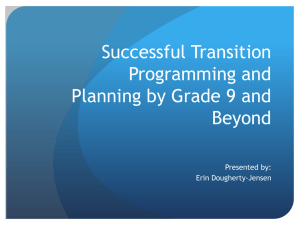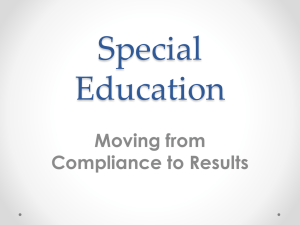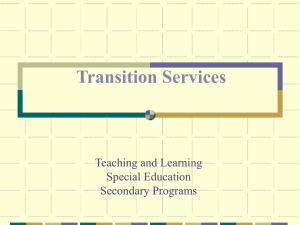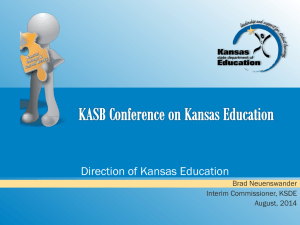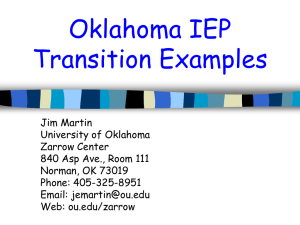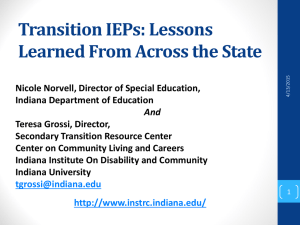Building Capacity for Monitoring Transition IEPs
advertisement
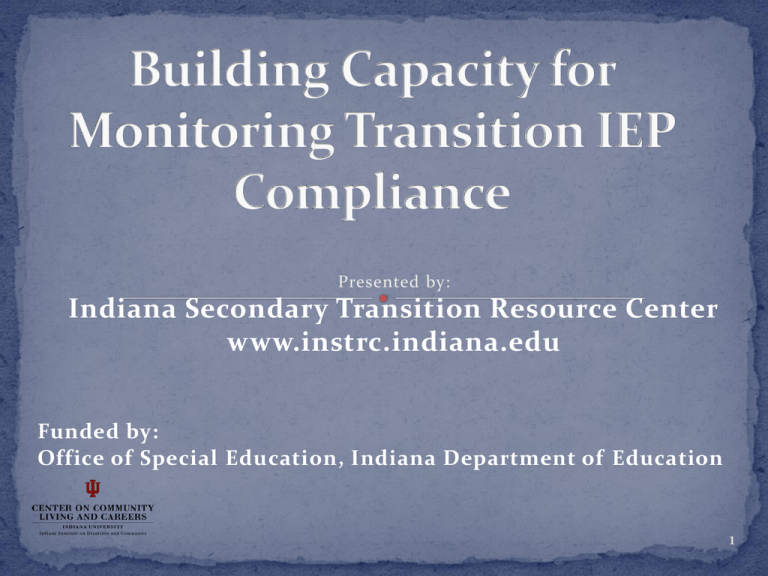
Presented by: Indiana Secondary Transition Resource Center www.instrc.indiana.edu Funded by: Office of Special Education, Indiana Department of Education 1 Learn about the Statewide Monitoring Process Recognize a compliant Transition IEP (vs writing one) Identify procedures for corrections Identify between myths and truths of compliant Transition IEPs Learn to align the Transition IEP components to ensure quality and compliance 2 ALIGN 3 http://www.youtube.com/watch?v=Ow0lr63y4Mw 4 = easily made mistakes or quick fixes = “whack-a-mole” for careless mistakes = time for questions and discussion 5 Districts are divided into 3 groups, rotation every 3rd year where your district’s data is submitted to the federal level –Office of Special Education Programs (OSEP) at the U.S. Department Of Education Every year 1 group of data is submitted OSEP The group that will be coming up for the next year’s submission or “proactive” group will be provided TA to improve data for following year. For example, group 2’s data is submitted to OSEP; group 3’s data is provided TA 6 Randomization of STNs of students 14 years and older occurs with two groups each spring – one group’s data goes federal level; other group spends upcoming year in TA to improve data for next year 3% of district SPED population or minimum of 3, maximum of 10 Transition IEPs are reviewed Review team spends from May through August/September reviewing Transition IEPs Report submitted IDOE September/October IDOE looks at districts with systemic issues 7 IEP needs to only meet minimal compliance Look for responses in other sections (PLAFP for some transition assessment or for alignment) Always remember it is a Case Conference Team Decision 8 March STNs requested for 2 groups May • Randomization • Review Team training with IDOE September/October Indicator 13 report submitted to IDOE November – April TA and correction for the “proactive group” – September-December Verification and correction for districts whose data will be May –August IEPs reviewed for submitted to OSEP that year compliance February Indicator 13 report submitted to OSEP by IDOE 9 10 11 1) Is there evidence that the student was invited to the Transition IEP Team meeting where transition services were discussed? Y N 12 13 Law says: “A transition IEP must contain the following: (1) A statement of the student's present levels of academic achievement and functional performance, including the following: (A) How the student's disability affects the student's involvement and progress in the general education curriculum. (B) Information from age appropriate transition assessments of: (i) strengths; (ii) preferences; and (iii) interests” 511 IAC 7-43-4 14 There is Nothing in the Present Levels section that is Monitored for Compliance . However . . . . . . . . . . . . It is The Beginning of a Story 15 Should be “Front Loaded” with data and information- it is the starting point for “connecting the rest of the IEP” or Aligning the Transition IEP Is relevant in that it is connected to the student’s disability and their needs (now and future settings) Shows how the disability affects their involvement or progress in the general education curriculum Data, Data and Data . . . “Would you know where to start instruction?” – stranger test 16 Jose participates in a Life Skills program. He works in the school cafeteria and at Wendy’s. He does a nice job following instructions and gets along well with all of his co-workers. Jose has stronger Math skills than Reading skills. He understands the next dollar strategy and can do basic addition and subtraction. Jose has difficulty with reading vocabulary words and comprehending what he has read. He goes to a general education Art class every day. He gets support as needed from either a peer tutor or a paraprofessional. OR 17 Jose is participating in a Life Skills program, where he is working on independent living and prevocational skills. Jose also participates in a community outing at least once a month with his class. Jose is in a general education Art class that meets daily. Jose is able to fill out a self- ID worksheet with minimal assistance. He still struggles with the spelling of his city and remembering his phone number. His calendar skills have improved. He is better at reading a calendar but still struggles with the spelling of the months and days of the week. Jose has improved when paying at restaurants. He has a good understanding of the next dollar strategy and understands how to leave a tip. He is very socially appropriate on school outings. He is always polite and respectful in the classroom and community. Jose has a job working in the dishroom in the school cafeteria. The cooks enjoy having him and he seems to like the job. He is able to rinse and put the dishes in the dishwasher with minimal support. He follows directions well and stays on task. Once in awhile he has to be reminded not to horseplay. 18 Jose also works one day a week at Wendy’s. He cleans before the restaurant opens (washing windows, tables, chairs, sweeping runs, etc.). He would like to go to Wendy’s more often. They love him and said he is a hard worker. Jose is able to use basic computation in addition and subtraction. He does have difficulty with basic multiplication and division. He multiplies single digit numbers with 65% accuracy. He divides double digit numbers with 40% accuracy. Jose shows weaknesses in word recognition, vocabulary, and comprehension. Of the 100 basic sight words, Jose can independently read 56, 75% of the time. When given every day things to read (recipes, newspaper, short passages), Jose has difficulty with words with more than 2 syllables. Jose is always willing to do whatever is asked of him and gives everything 100%. 19 Post-Secondary Goal Areas 2) Are there measurable postsecondary goals in these areas? Education/ Training Y N Employment Y N Independent Living Y N N/A a) Can the goal(s) be measured? b) Will the goal(s) occur after the student graduates/transitions from school? - If 'Yes' to both these questions, then circle 'Y'. If a postsecondary goal is not stated, circle 'N' for 'No' 20 Not following the drop down menu for a grammatical correct sentence - For employment “After high school, I will enroll to be a welder.” Putting employment postsecondary goal under education/training or ILS or vise versa Writing a “paragraph” requiring the reviewer to “dig” for the goal 21 3) Is there evidence that the measurable post-secondary goals were based upon an ageappropriate transition assessment? Education/ Training Y N Independent Employment Living Y N Y N N/A Is the use of a transition assessment(s) for the post-secondary goal(s) mentioned in the Transition IEP or evident in the student's file? 22 Law says: Appropriate measurable postsecondary goals based upon age appropriate transition assessments related to training/ education, employment, and where appropriate, independent living skills Information from age appropriate transition assessments of: (i) strengths; (ii) preferences; and (iii) interests” 511 IAC 7-43-4 23 Transition assessment . . . “ongoing process of collecting data on the individual’s needs, preferences, and interests as they related to the demands of current and future working, educational, living and personal and social environments. Assessment data . . .form the basis for defining goals and services to be included in the Individualized Education Program” [(Sitlington, Neubert, & Leconte, 1997, p. 70-71); Division of Career Development and Transition (DCDT)] 24 Identify the assessment and summarize the findings /results Findings/results are based on preferences, interests and strengths as well as support needs Align to present levels and postsecondary goals 25 Nothing written but grades , ECA, copy of PLAFP or what the teacher thinks of the student Assessments identified but no summary Summary of “something” but nothing identified Doesn’t “align” with PLAFP and postsecondary goal (e.g., summarizes information about handon activities, welder, etc. then postsecondary goal is to go to college to study hotel management) Same transition assessment given every year . . . and to every student . . . . (Systemic) 26 27 Defined as “those skills or tasks that contribute to the successful independent functioning of an individual in adulthood” (Cronin, 1996) in the following domains: leisure/recreation, maintain home and personal care, and community participation. IT’S MORE THAN WHERE SOMEONE LIVES!!! [NSTTAC-National Secondary Transition Technical Assistance Center] 28 An IL goal is written but no transition assessment with information to support it or annual goal to align with it No IL goal is written but the need is stated in the transition assessments or in the PLAFP Quality issue – just focus on where someone wants to live . . . . 29 30 Education/ Employ Independent 4) Are the post-secondary Training ment Living goals updated annually? Y N Y N Y N N/A Is there evidence that the post-secondary goals have been discussed and continue to be relevant. 31 The intent is to make sure the postsecondary goals are still relevant for the student(e.g., middle school – NFL player and high school -work in the auto industry) Changes over time– are the goals still relevant Non-IIEP users – sometimes difficulty finding it 32 5) Is there documentation regarding whether the student will pursue a high school diploma or certificate of completion? Y N Is the discussion documented in the Transition IEP or evident in the student's file? 33 6) Is (are) there measureable annual Transition IEP goal(s) that reasonably enable the student to meet his/her postsecondary goals? Education/ Training Y N Independent Employment Living Y N Y N N/A Are the annual goals included in the Transition IEP measurable and will they help the student make progress toward the stated postsecondary goal(s)? 34 35 The Law says: (A) A statement of measurable annual goals, including academic and functional goals designed to support and align with the student's postsecondary goals, that meet: (i) the student's needs that result from the student's disability to enable the student to be involved in and make progress in the general education curriculum; and (ii) each of the student's other educational needs that result from the student's disability. (B) For students who participate in alternate assessments aligned to alternative academic achievement standards, a description of benchmarks or short-term objectives. 36 (7) A description of the following: (A) How the student's progress toward meeting the postsecondary and annual goals described in subdivision (6) will be measured. (B) When periodic reports on the progress the student is making toward meeting the postsecondary and annual goals (such as through the use of quarterly or other periodic reports, concurrent with the issuance of report cards) will be provided. 37 Must relate to the PLAFP Annuals goals (and short-time objectives or benchmarks) should be able to stand on their own Identifies what knowledge, skills and/or behaviors a student is expected to demonstrate or do within the period of time the IEP is implemented At least one of the annual goals must support each of the measurable postsecondary goals What skills does the student need to be successful in current and future environments? (e.g., learning strategies, organizational skills, etc.) 38 GIVEN WHAT – describes the conditions that will need to be in place for the goal (or benchmark) to be completed WHO – the student DOES WHAT – describes observable behavior (specific action) that the student will do to complete the goal (or benchmark) WHEN (for benchmarks specifically) – relates to a specific point in time or timeframe when something will have been learned or completed– this relates to the life of the IEP. 39 HOW MUCH Mastery – describes the performance accuracy of the behavior to be considered completed Criteria – describes how many times the behavior must be observed for the goal or (objectives/benchmarks) to be considered completed or mastered HOW WILL IT BE MEASURED – describes performance data (progress monitoring) [www.calstate.org/iep] 40 By the end of the 36 weeks and using a 7th grade-level reading passage, Michael will be able to correctly answer questions regarding the elements of the main idea using context clues, sequencing, and organization of language with 85% accuracy with 4 our 5 opportunities. (single point based on quiz scores) 41 Goals written as a measurement (Johnny will increase his reading on the matrix program from 2.4 to 3.5.) Too many goals in one statement (Johnny will tell time to the 15 minutes intervals, complete 2-digit multiplications and division, and be prepared for his work) Vague goals (Jim will demonstrate self-advocacy skills 100% of the time for all academic subjects or Keith will improve his skills in Algebra I to demonstrate mastery of the Indiana Academic Standards with 80% accuracy.)) Passing Classes . . . .. (Tim will maintain at least a 70% in his English class or will pass the ECA) 42 Not skills based – Tom will respond appropriately to his peers No baseline data to know the starting point Writes goals to fit the progress monitoring tool vs student needs Using a monitoring tool that is based on a program (not all schools have the program, e.g., student moves-in) 43 44 7) Are there transition services in Education/ Independent the Transition IEP that focus on Training Employment Living improving academic and functional achievement of the student to facilitate their movement from school to postschool? Y N Y N Y N N/A 45 …means a coordinated set of activities for a student with a disability that . . . [511 IAC 7-32-105] 46 46 Law says: (4) The transition services, as defined at 511 IAC 7-32-100, needed to assist the student in reaching postsecondary goals, including the individuals and agencies identified for implementing the transition services. (5) If appropriate based upon the transition services identified in subdivision (4), documentation that the CCC reviewed information, and the public agency presented written information to the parent and student, regarding available adult services provided through state and local agencies and other organizations to facilitate student movement from the public agency to adult life. 47 . . . Must be based on the individual student’s needs, taking into account the student’s strengths, preferences, interests , including the following: 1) instruction; 2) related services; 3) community experiences; 4) the development of employment and other postschool adult living objectives; and 5) when appropriate, acquisition of daily living skills and provision of a functional vocational evaluation Refer to handout for definitions and examples 48 Schools need to be part of the service delivery Think beyond “giving an assessment” only Need to have something aligned to support each postsecondary goals ECA’s are not a transition service Reviewing a GPA with a counselor is not a transition service Use the narrative to further explain or justify 49 Education/ Training 8) For transition services that are likely to be Y provided or paid for by other agencies with parent or student (once the age of majority is reached) consent, is there evidence that representatives of the agency(ies) were invited to the Transition IEP meeting? IndepenEmployment dent Living N/ N N/A Y N N/A Y N A 50 Age of Majority signatures If an outside agency (e.g., VRS, Medicaid Waiver) is going to provide and/or pay for a transition service such as situational assessment, psychological test, etc.), they must be invited You cannot assign VRS or other agencies to conduct transition services without them at the actual meeting If the process with VRS is already occurring (e.g., referral and application), you can discuss it in the transition assessment section or the transition services section- give yourself credit with the goal to get students access to services. 51 Independent 9) Do the transition services include a Education/ Training Employment Living course of study that focuses on improving the academic and functional Y N Y N Y N N/A achievement of the student to facilitate their movement from school to postschool? Do the transition services include courses of study that align with the student's post-secondary goal(s)? 52 Each section of Indicator 13 questions for compliance (and quality) are interrelated Once you see the big picture . . . You have a cohesive and aligned document that guides your instruction/services for students 53 Teresa Grossi - tgrossi@indiana.edu Joni Schmalzried – jeschmal@indiana.edu Faith Thomas – fmthomas@indiana.edu Mary Held – maheld@indiana.edu 54

